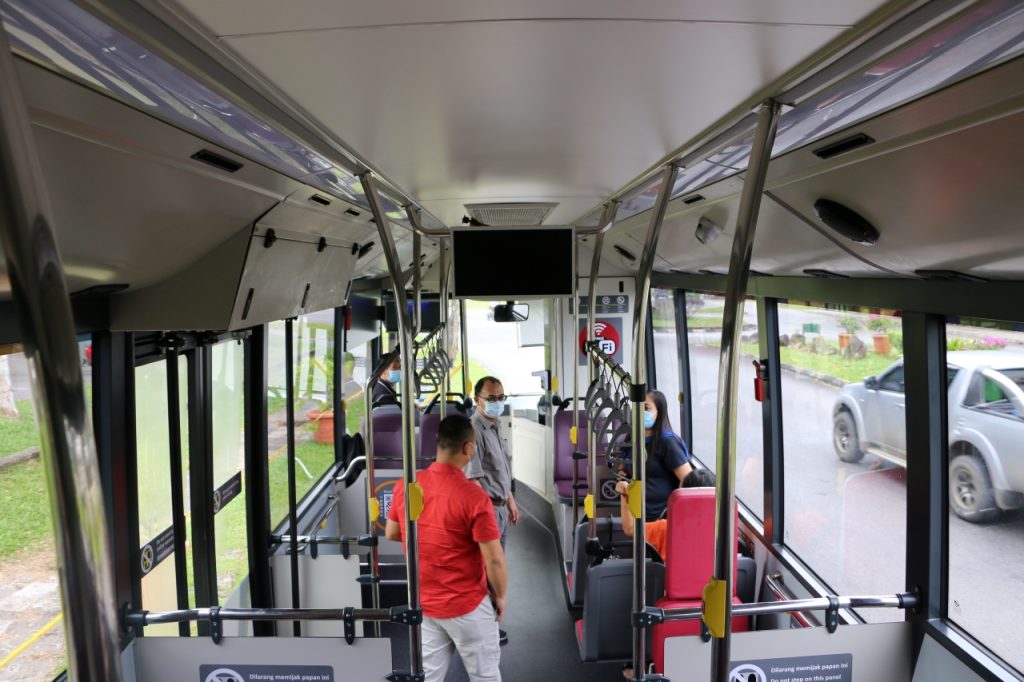Sarawak’s first ever electric city bus service is a great addition to its urban public transport system and has a massive potential not only in becoming a green alternative for environmentally conscious passengers but also in providing convenience for everyday commuters.
This was the general opinion of the RAKAN Sarawak team during a recent trip in one of four electric buses operated under the Kuching Metro City Electric City Bus Service along Route 103, which is from the State Legislative Assembly (DUN) to Semenggoh Wildlife Centre and vice versa.
The route itself has over 50 stops, covering tourist destinations, commercial areas, public transport facilities and various other public areas within Kuching – all of which are accessible for tourists and locals alike.

There are six departure times from either DUN or Semenggoh Wildlife Centre, with the first at 6.00am and the last at 4.00pm. Depending on traffic, road condition and passenger presence at each bus stop, a one-way trip on the bus can take less or more than two hours.

Those who wish to take any of the four electric buses as part of their travel can track movement of these buses in real time via the Kuching Metro mobile app (available on the Apple App Store, Google Play and HUAWEI AppGallery), which also features bus routes, bus schedule and a route map.

It is worth noting that unlike conventional, fuel-powered buses, these electric buses will only stop at assigned bus stops and cannot be halted at random spots to avoid power wastage.
As such, passengers who want to take any of these buses should find the bus service’s rather distinguishable signboard at specific stops.
This signboard is mostly in red and black, and features the name of the bus stop, the bus route map, as well as a QR code that will enable passengers to download the Kuching Metro app on their smartphone.
A user-friendly public transport
Each electric bus can carry up to 52 passengers, with 26 seated and 26 standing.
These passengers can include the elderly, pregnant women, mothers with babies or young children and disabled individuals, all of whom are given designated seats (coloured in red, compared to regular seats which are in purple).

There is also a space to store folding bicycles for cyclists who want to take their two-wheel vehicles on the bus as part of their overall commuting plan.
Additionally, six closed circuit cameras (CCTV) are installed in every corner of the bus so that passengers can feel secure when they travel.
Given the need for people to remain virtually connected in this day and age, the free WiFi service – which is generally stable throughout the trip – will be a boon for passengers who want to surf the Internet, scroll through their social media or complete any task that requires Internet connectivity before reaching their destination.
However, fair warning to tall or large-sized individuals, for seats in the bus are mostly small and the standing area is not very roomy, which may not be comfortable for those who do not like cramped spaces.
Room for Improvement
Despite being a free electric city bus service, not many among the general public are aware of its existence, likely due to the service being launched quite recently in early March 2021 and Sarawak having yet to open its doors to international visitors due to the ongoing COVID-19 pandemic.
Still, until tourists can travel to Sarawak and locals begin to hear more about the service, certain aspects need to be addressed to enhance the experience of riding this environmentally friendly public transport.
Among them is adding a feature in the Kuching Mobile app that notifies users of the number of passengers in each bus. For some, the number of passengers in the bus will determine their decision to enter the public vehicle.

To encourage more local commuters to take the electric bus, conditions of bus stops and their surroundings should be improved.
For example, each bus stop should have a shelter, comfortable seats, a litter bin and proper lighting to ensure passengers’ comfort and safety as they wait for the bus, especially on rainy days.

Proper pavement should also be constructed to provide greater accessibility for passengers to walk to these bus stops.
Furthermore, more secure car parks would offer convenience for passengers who are considering of leaving their private vehicles to take the public transport to their chosen destination.
When more electric buses are added into the service, additional routes should be considered to cover more destinations in Kuching that are frequented by the public, such as Sarawak General Hospital, Batu Kawah and Matang.
In the long run, continuous improvement on the electric city bus service might convince the public and international visitors to take the public transport as a way to protect the environment, thereby contributing to Sarawak’s socio-economic progress through the digital economy and sustainable development.






